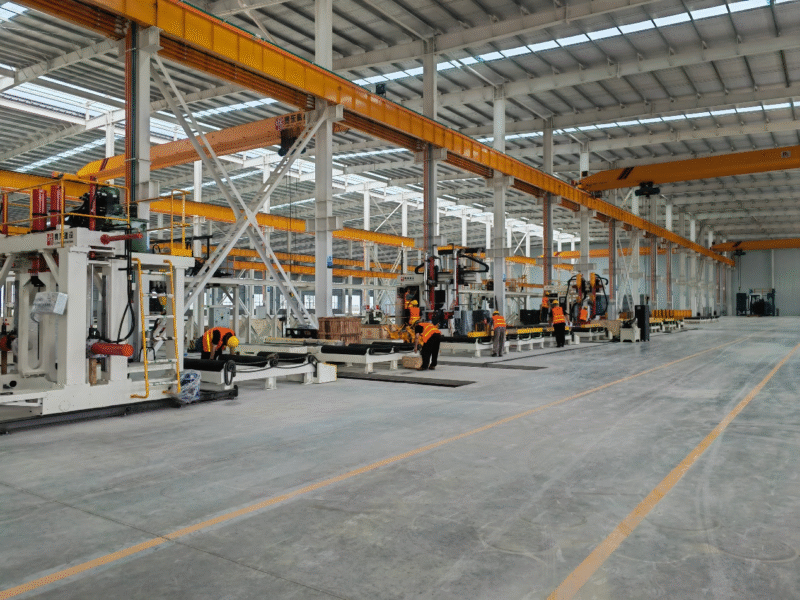
Modular Poultry Houses: Efficient, Hygienic, and Scalable Solutions for Modern Chicken Farms
The global poultry industry is rapidly modernizing, with farm owners and investors seeking housing systems that balance efficiency, hygiene, and cost control. Traditional brick-and-mortar chicken houses are slow to build, hard to maintain, and less adaptable to changing production demands.
Modular poultry houses—constructed using prefabricated steel and insulated panels—are transforming this landscape. Designed for flexibility, speed, and biosecurity, they enable farmers to expand production capacity, enhance animal welfare, and reduce long-term costs.
This article explores how modular poultry houses are reshaping modern chicken farming for both small-scale producers and large integrated operations.
What Are Modular Poultry Houses?
Modular poultry houses are prefabricated buildings composed of steel frames, sandwich panels, and advanced ventilation systems. Each unit is pre-engineered in a factory, then transported and assembled on-site in a fraction of the time required for conventional construction.
Their modular nature means farms can easily expand by adding new sections as production grows. Whether for broilers, layers, or breeders, modular poultry houses offer customizable designs to meet specific environmental and operational needs.
Advantages of Modular Poultry Houses
- Fast and Cost-Effective Installation
Prefabricated modules are manufactured in controlled environments and assembled quickly on-site, reducing project time by up to 60%. - Superior Hygiene and Biosecurity
Smooth, non-porous interior surfaces prevent bacteria buildup. Efficient cleaning and disinfection reduce disease risks and improve overall flock health. - Optimized Climate Control
Advanced ventilation systems and insulated panels ensure consistent airflow, humidity control, and temperature stability—critical for poultry growth and productivity. - Energy Efficiency
Thermal insulation minimizes energy consumption for heating or cooling, significantly lowering operational costs. - Expandable and Flexible Design
Modular systems make it easy to expand capacity without major reconstruction. New modules can be added as demand increases. - Durability and Longevity
Galvanized steel frames resist corrosion, ensuring structural integrity for decades even in humid poultry environments.
Design Considerations for Poultry Farms
When planning a modular poultry house, B2B buyers and investors should consider:
- Ventilation System Design: Mechanical or natural ventilation systems depending on climate and bird density.
- Lighting Control: LED systems and adjustable light schedules to improve feed conversion and egg production.
- Feeding and Watering Automation: Integration of automatic feeders and drinkers for uniform growth and reduced labor.
- Biosecurity Layout: Separation of clean and dirty zones to prevent cross-contamination.
- Insulation Performance: High-quality sandwich panels for optimal temperature regulation.
Applications in Poultry Production
Modular poultry houses can serve a variety of purposes:
- Broiler Houses: For fast-growing meat chickens requiring tight climate control.
- Layer Houses: Designed for egg-laying hens with optimized lighting and nesting systems.
- Breeder Farms: Controlled environments for parent stock breeding programs.
- Multi-Stage Facilities: Integrating rearing, production, and processing areas under one modular complex.
Global Adoption Examples
- Vietnam Poultry Farm Expansion:
A 50,000-bird broiler farm upgraded to modular housing, achieving 20% lower mortality and 30% faster assembly time. - Middle East Egg Production Facility:
Installed modular layer houses with automated feeding and cooling systems, boosting egg yield by 18%. - African Poultry Cooperative:
Deployed modular poultry houses to scale production quickly in remote areas, thanks to easy transport and assembly.
Why B2B Clients Choose Modular Poultry Houses
For distributors, contractors, and agribusiness investors, modular poultry houses deliver:
- Rapid ROI (Return on Investment) due to faster project completion.
- Low Maintenance Costs thanks to durable steel and easy-clean materials.
- Operational Flexibility with scalable layouts and modular add-ons.
- Improved Animal Welfare through stable indoor environments.
- Sustainability via recyclable materials and reduced energy usage.
By combining industrial efficiency with agricultural functionality, modular poultry houses offer the ideal infrastructure for the next generation of poultry farming.
Conclusion
Modular poultry houses represent the future of efficient and scalable poultry production. They reduce construction time, improve hygiene, and ensure optimal conditions for flock health and productivity.
For B2B clients and poultry investors, these prefabricated solutions offer unmatched value—combining flexibility, durability, and long-term profitability in one modern housing system.
